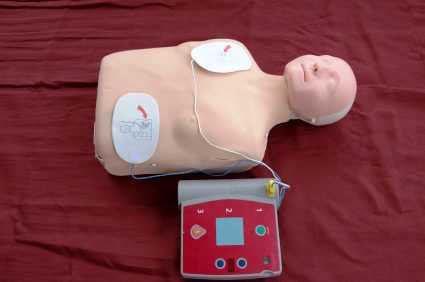Study details
Researchers at the University of Washington in Seattle surveyed over 2,100 high schools located in all 50 states, 87% of which had AED programs. They found that:
In terms of emergency planning:
- Of schools with at least one AED, the mean number of devices per school was 3.1;
- 83% had a written emergency action plan for SCA, of which two thirds were developed in consultation with local EMS;
- School personnel most likely to be trained in CPR were coaches (80% of schools), school nurses (77%), athletic trainers (68%), and administrators (65%)
- School personnel most likely to be trained in AED use were coaches (75%), school nurses (75%), ATs (65%), and administrators (65%)

- Only 45% of schools reviewed and practiced their emergency response to SCA at least once per year and only 20% of schools posted their EAP at athletic venues.
- Of those schools without AEDs, 263 schools identified one or more of the following obstacles to obtaining one:
- limited financial resources (80%)
- medicolegal concerns (24%)
- uncertainty about placement (13%)
- school policy (10%) and
- unproven cost-effectiveness (1%)
In terms of SCA cases, the study reported:
- 59 confirmed cases of SCA
- 47 (80%) were males.
- 22 (20%) were females
- 26 (44%) occurred in students (mean age 16):
- 18 (69%) were student-athletes
- 16 (89%) male
- 2 (11%) female
- 8 (31%) non student-athletes
- 4 males
- 4 females
- 18 (69%) were student-athletes
- 33 (56%) occurred in adults (mean age 56)
- 10 (30%) were spectators
- 9 (27%) were visitors to campus
- 7 (21%) were school staff
- 4 (12%) were athletic officials
- 3 (9%) were coaches.
- 27 (82%) were male
- 6 (18%) were female
As far as the location and setting where the SCA occurred:
- Athletic facilities accounted for two-thirds of all cases (66%)
- 20 (34%) during games
- 19 (32%) during practices
- 27 (46%) cases were in persons participating in physical activity on the school campus such as student-athletes, officials, and visitors using athletic facilities
- Basketball and football were the most frequent sporting events in which SCA occurred (13 and 9 cases respectively)
- Baseball (3)
- Track & Field (3)
- Ice hockey (2)
- Soccer (2)
- Softball (2)
- Cheerleading (1)
- Cross-country (1)
- Lacrosse (1)
- Swimming (1)
- Wrestling (1)
- Non-sporting event: 16 (27%) in classroom building and 4 (7%) in a parking lot.
In terms of the emergency response to the SCA victim:
- 55 witnessed (93%) overall and all involving a student-athlete
- In 40 cases the presence or absence of seizure-like activity was reported
- Brief seizure-like activity after collapse was reported in 36% of adults and 38% of student-athletes
- First responders:
- Administrative staff (22)
- ATs (21)
- Lay visitors (19)
- School nurses (19)
- Coaches (17)
- Teachers (17)
- EMS at athletic events (3)
- Average estimated time to arrival of EMS when no onsite AED: 7.8 minutes
- CPR provided by lay responders or onsite EMS in 54 cases (92%)
- School-based AED present in all but one of SCA cases reported, and was brought in all cases
- AED used in resuscitation:
- Onsite AED in 41 cases (70%)
- Brought by offsite EMS in 15 (25%)
- In 3 (5%) by onsite EMS
- Application of AED confirmed in 50 (85%) cases
- Shock delivered in 39 (66%) cases.
Survival rates varied, but were generally much higher than those reported in previous studies, especially for exercise-related SCA in young athletes:
- 42 of 59 (71%) SCA victims survived to hospital discharge, including:
- 20 of 33 (66%) adults
- 22 of 26 (85%) students
- Survival in males was 75% and 58% in females
- 16 of 18 student-athletes (89%) survived
- 8 of 9 (89%) of adults who arrested during physical activity
- 80% of SCA victims survived to hospital discharge if the school supplied the AED used in resuscitation versus only 50% if the defibrillator was brought by the responding offsite EMS
- The survival rate was 79% in schools with an established emergency action plan for SCA versus 44% in those without.
- None of the unwitnessed cases of SCA survived to hospital discharge.
Important public safety measure
"High school AED programs demonstrate a high survival rate for students as well as adults who suffer SCA on school campus. SCA is the leading cause of death in the USA and the leading cause of death in exercising young athletes. School-based AED programmes represent an important public safety measure and an effective strategy for the prevention of sudden cardiac death during sports. Schools are a strategic location to serve large concentrations of people at risk for SCA and school-based AED programmes should be strongly supported," the study concludes.
1. Drezner JA, Toresdahl BG, Rao AL, et al. Outcomes from sudden cardiac arrest in US high schools: a 2-year prospective study from the National Registry for AED Use in Sports. Br J Sports Med. 2013:47:1179-1183 (originally published online October 11, 2013); doi:10.1136/bjsports-2013-092786.
2. Toreshdahl B, Harmon K, Drezner J. High School Automated External Defibrillator Programs as Markers of Emergency Preparedness for Sudden Cardiac Arrest. J Athl Train 2013;48(2):242-247.








